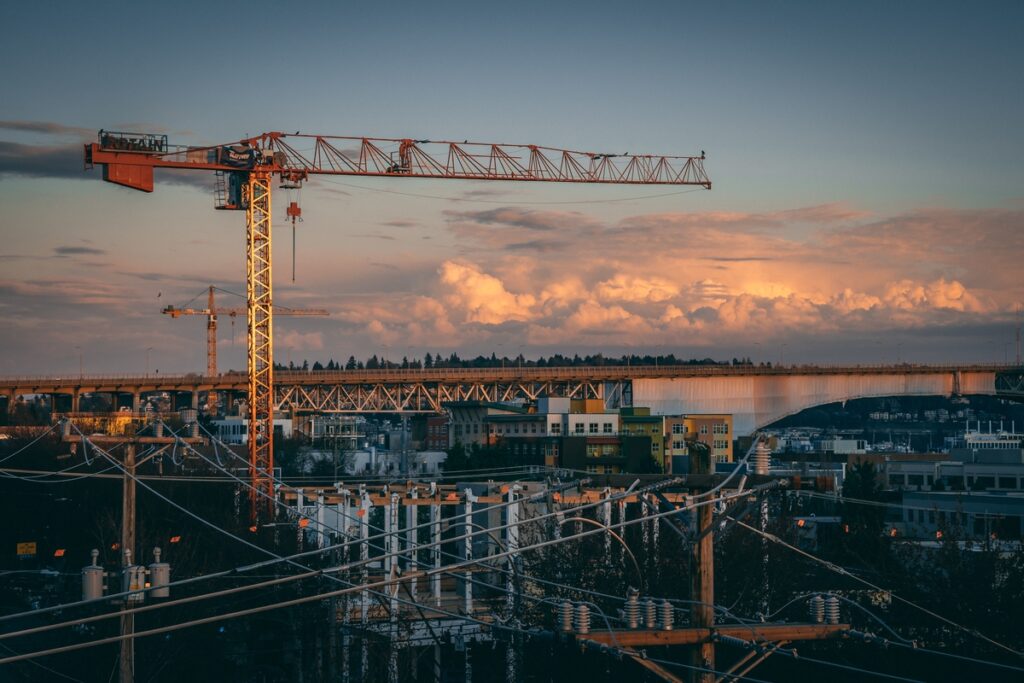Exclusive Neuroject Article: Our buildings are an excellent place to start when speculating about the future. Science fiction frequently envisions futuristic huge structures and cybernetic skyscrapers. These aspirations are realized in smart building examples. Smart Buildings symbolize the progress of modern infrastructure and how it interacts with automated control systems, data processing, and artificial intelligence (AI). Buildings that are “smart” have become more common because they provide a variety of potentially useful services.
considerable advantages for occupants, building managers, and owners. These include efficiency gains through lower operating and maintenance expenses, less energy consumption, and increased comfort and safety for building occupants. When utilized properly, smart building technology can be used to make our buildings healthier, more effective, and more sustainable, just like One-Key can help you better customize, track, and handle your tool inventories.
They don’t seem outlandish at all; in fact, they seem to be doing well. Grand View Research, a consultancy, projects that the worldwide smart building industry will develop at a compound annual growth rate (CAGR) of 25.3% from now until the end of the decade, reaching $570 billion.
Table of Contents
An Introduction to Smart Building Examples
The concept of smart buildings, or at least a discussion of it, dates back to the early 1980s. In 1984, for instance, a New York Times article described real estate developers creating “a new generation of buildings that almost think for themselves . . . called smart buildings.” Such a building was defined as “a marriage of two technologies—old-fashioned building management and telecommunications.”
Big data, the Internet of Things (IoT), building information modeling (BIM), artificial intelligence (AI), building management systems, and sustainable building practices all come together in smart buildings. These and other revolutionary innovations are used by smart building examples to improve their functionality, comfort, and safety.
Although “green” and “smart” buildings are two distinct concepts that are sometimes used collectively, as we shall see, they do not always conflict. Despite the fact smart building examples contain numerous distinctive qualities, they may be condensed down to two main characteristics:
- Connectivity: A smart building’s “IQ,” if you will, is greatly affected by how interconnected its many systems are and how well they can exchange information with one another.
- Automation: Compared to conventional structures, smart buildings exhibit a higher level of self-management and are capable of performing at least some of their core activities automatically, mostly without the need for human interaction.
A building’s “smartness” can be determined, for instance, by looking to see if it has a SmartScore or WiredScore certification. These evaluation tools, created by a group of private real estate companies, rate a building’s connection to the internet and overall technological quality, much like how LEED or BREEAM evaluates a structure’s environmental friendliness.
Suggested article’s for reading: IoT in Construction | Big Data in Construction | BIM in Construction | AI in Construction
1. THE EDGE
- Location: Amsterdam, Netherlands
- Type: Office
- Size: 15 stories / 40,000 sq. meters
- Architect: London-based PLP Architects
- Completion Date: 2014
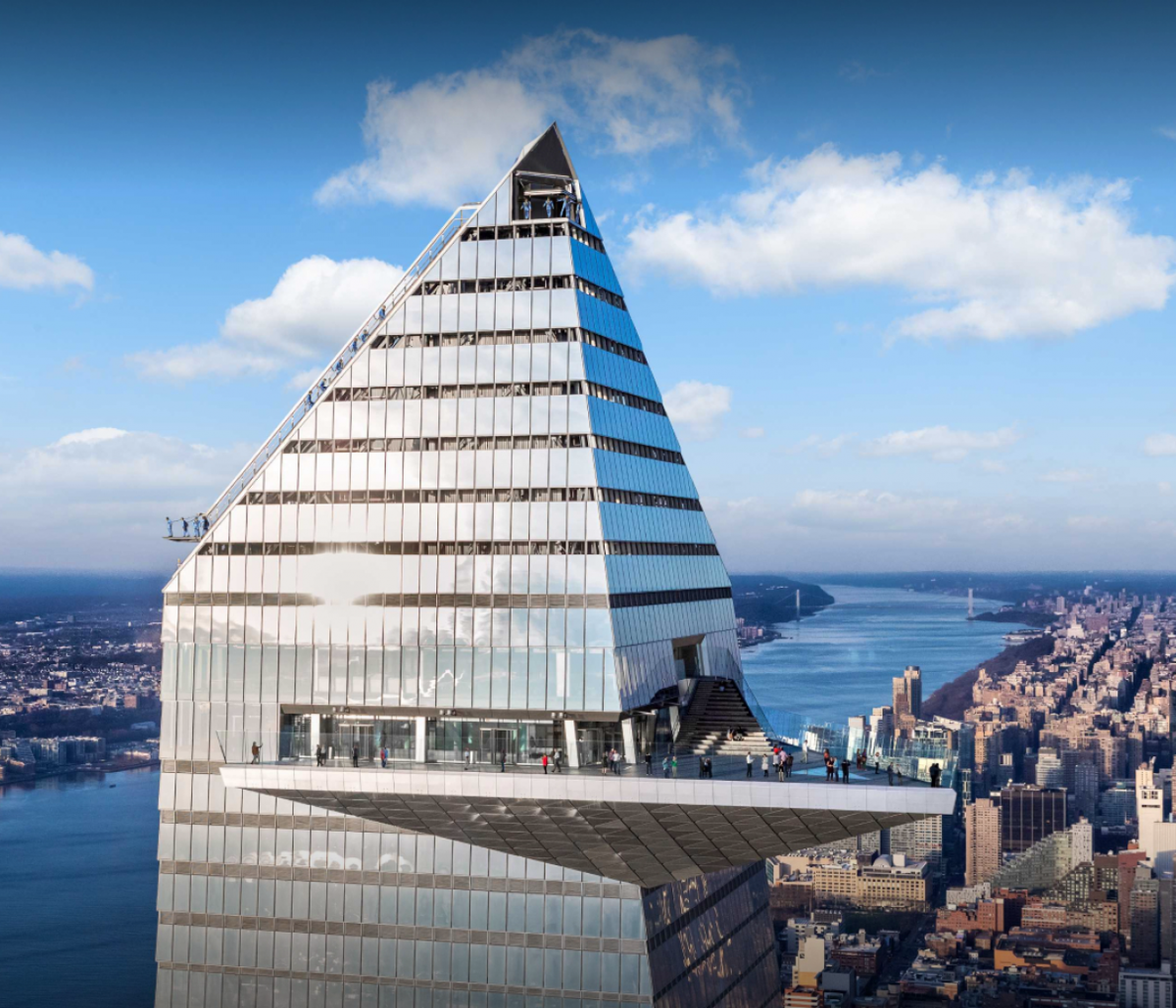
What better way to begin our smart building examples list than with the world’s smartest structure?
That is how the Edge, Deloitte’s Amsterdam headquarters, has been characterized in the pages of Bloomberg. The Edge, which includes more than 28,000 Iot sensors and a plethora of other smart features, has an ” exceptional ” BREEAM score, making it one of the greenest buildings in the world.
If you worked at the Edge, you would begin each day by establishing an online connection with the structure using Mapiq, a smartphone software that can do anything from point you in the direction of open parking, change the thermostat, arrange your workout schedule, or book a workspace. That’s because nobody at the Edge has a desk that is always theirs. Instead, employees can wander about the facility and reserve various workstations that are tailored to their schedules and comfort preferences via an app. The Edge can accommodate 2,850 employees across 1,080 desks using this method.
The Edge has too many smart features to list here, from smart panels and data dashboards to security robots and automated coffee makers, but one of the most noteworthy for our purposes is its expert use of BIM to visualize energy efficiency and monitor maintenance issues, a prime example of how 6D BIM can be used to make buildings more sustainable.
The Edge is a “net-zero” building, which means that 100% of its energy comes from renewable resources. Its 4,200 square meters of solar panels, the majority of which are situated on the rooftops of nearby structures (that’s a big job if you’re a solar photovoltaic installer), provide all of the building’s energy. 500 bicycles can be parked in the basement, which also contains a bank of electric car charging outlets.
Ironically, The Edge’s smart use of low-tech, passive design characteristics is what contributes most to its sustainability profile. The construction’s southern facade’s load-bearing concrete walls particularly serve as a thermal mass, absorbing and dispersing heat from the sun. The remaining heating requirements of the building are met by a geothermal heat pump system.
Suggested article for reading: Zero Energy Buildings (ZBE)
2. GLUMAC: SHANGHAI HQ
- Location: Shanghai, China
- Type: Office
- Size: 6,450 sq. ft.
- Architect: Collaboration between Glumac, sustainability consultants Terrapin Bright Green, San-Francisco based architecture firm Gensler, Japanese construction company Shimizu, and Shanghai-based green materials consultant GIGA
- Completion Date: 2014
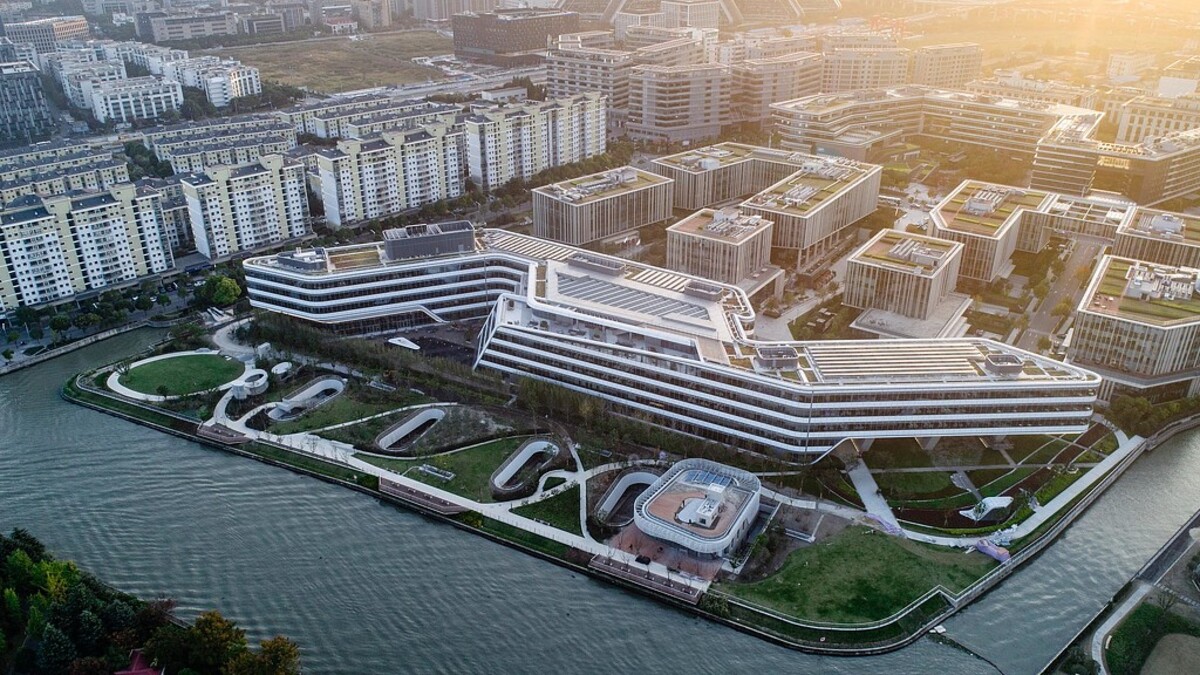
A sophisticated air purification and monitoring system serves as the main smart feature in this instance. Since air pollution has long been a significant problem in China’s main cities, engineering company Glumac gave interior air quality first priority when remodeling its Shanghai office space, which is located on the third story of the 100-year-old Rockefeller Mansion.
The outcomes? The Glumac headquarters in Shanghai are the first net-zero energy, water, and carbon project in Asia thanks to their platinum LEED accreditation and full-petal Living Building approval.
Low-flow fixtures have reduced water use by 63%, while water and recycling systems have produced almost three times as much as the residents need. All of the energy is generated by solar, and a large portion of the structure is designed with biophilic concepts, which increase a building’s livability and health by allowing residents more opportunities to interact with nature. The living green wall in the area, which has plants that filter the air, is a great illustration of this in action.
This takes us to the building’s remarkable air-purification system, which is the main attraction for our purposes. A mobile application called RESET, which also provides details about the office’s plant life’s capacity to filter the air, allows building occupants to receive real-time information regarding indoor air quality.
Suggested article for reading: Construction Monitoring
3. 800 FULTON MARKET
- Location: Chicago, Illinois
- Type: Mixed Use
- Size: 19 stories / 90,000 sq. ft.
- Architect: Skidmore, Owings & Merrill
- Completion Date: 2021

The following entry, though, is almost all new and calls itself “the smartest building in Chicago.” This bold claim is undoubtedly supported by the receipts and some outstanding health and sustainability credentials of 800 Fulton Market: The design of this smart building has earned LEED Platinum, WELL Gold, and platinum certifications from the two smart building standards we previously mentioned: SmartScore and WiredScore.
More than 8,000 IoT sensors for recording occupancy data and a cloud-based management platform that connects 12 distinct building systems are just a couple of the smart features the building has to offer. The building’s website states that a smartphone app gives renters access to a digital space where they can arrange meetings, manage the atmosphere, sign up for fitness courses, and get alerts about discounts at nearby restaurants.
4. THE EMPIRE STATE BUILDING
- Location: New York City, New York
- Type: Office
- Size: 102 stories / 2.7 million sq. ft.
- Architect: Shreve, Lamb & Harmon
- Completion Date: 1931

Perhaps the most notable skyscraper ever constructed has recently emerged as one of the fantastic smart building examples of how modern innovations can be applied to achieve the green retrofits of older buildings. According to a CBC story, the $38 million effort to lessen the Empire State Building’s carbon footprint (see building facts) was launched in 2006 and has been a huge success, reducing the structure’s energy usage by as much as 50%. According to the group that owns the building, carbon neutrality will be attained by 2030.
The Empire State Building’s energy efficiency has increased from one of the lowest in New York City to one of the highest. Triple-paned windows, improved insulation, regenerative lift braking, and a significant chiller plant upgrade that included the installation of CO2 trackers and a sophisticated temperature control system. The structure also makes use of an AI platform, which is said to have reduced carbon emissions by 300 metric tons and water use by 7.5 million gallons.
According to Anthony Malkin, CEO of the Empire State Realty Trust, “There is no magic solution.” Silver buckshot is used. There are numerous components that come together to form it. The renovation was so successful that it inspired the development of the Empire Building Challenge, a $50 million initiative to encourage other iconic New York City buildings to undertake similar green retrofits.
5. BURJ KHALIFA, DUBAI
- Location: Burj Khalifa Park by Emaar
- Type: skyscraper
- Size: 309,473 m2 (3,331,100 sq. ft.)
- Architect: Adrian Smith, George J. Efstathiou, Marshall Strabala
- Completion Date: January 4, 2010

Dubai is a pioneer in the field of intelligent construction. According to Honeywell, the nation’s smart building score, which considers a facility’s sustainability, safety, and productivity, is 65 out of 100. With a height of 2,716 feet and 160 floors, the Burj Khalifa already held the prestigious title of being the highest building in the world. (To put it into perspective, that is taller than the Empire State Building by more than double!) Additionally, it has always been a cutting-edge innovator.
But with Honeywell’s assistance, it has become one of the most advanced and environmentally friendly smart building examples. In its main venue, Honeywell collaborated with building managers to implement a number of smart building examples that enhanced the residents’ access to better air quality, lighting, and temperature control. The IoT platform from Honeywell receives real-time data from the intelligent building automation system and employs clever algorithms to spot anomalies and maintenance problems. This information can be used by facility managers to increase asset reliability and building upkeep.
6. DUKE ENERGY CENTER, CHARLOTTE, NC
- Location: NC, United States
- Type: Office building
- Size: 1,370,214 square feet (127,297.0 m2)
- Architect: Tvsdesign
- Completion Date: January 2010
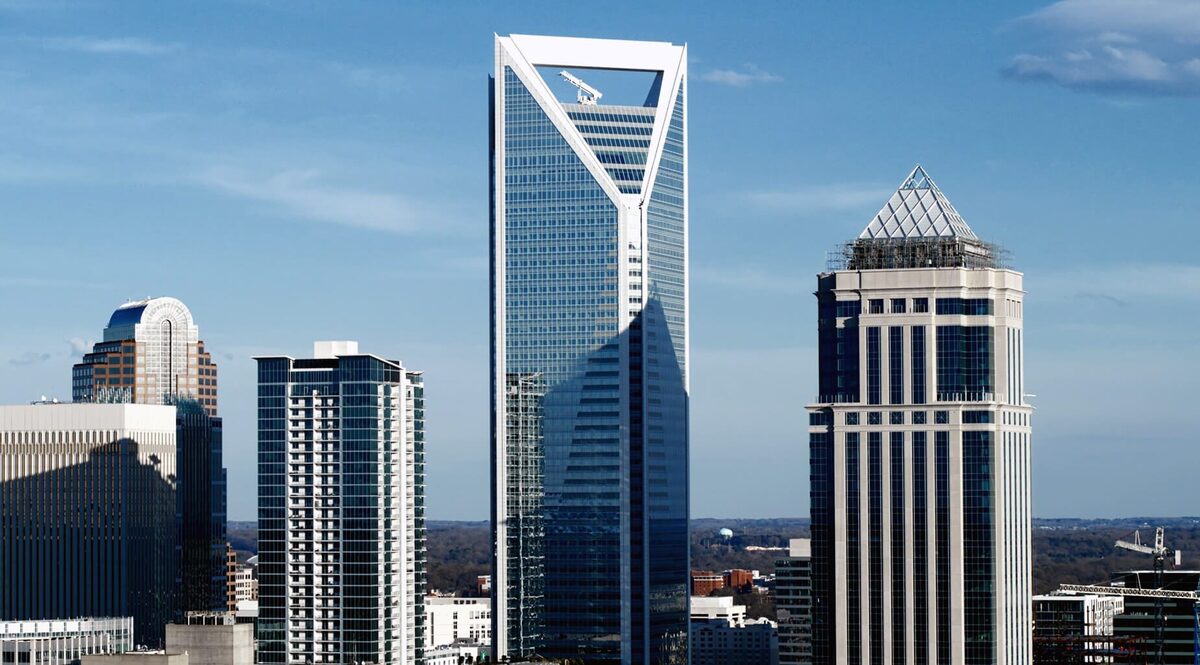
This 51-floor skyscraper (with 48 occupied stories) belongs to Wells Fargo and is home to Duke Energy. It features LEED Platinum, the highest level of sustainability certification among the smart building examples. The building is able to reuse about 10 million gallons of collected water annually, including groundwater, rainwater, and HVAC condensation, which covers all of the building’s irrigation needs and about 80% of the needs for the cooling tower.
There is a manicured roof garden, which employs the plants to absorb extra heat while lowering storm water run-off. In order to reflect light farther into the interior and provide more natural light, daylight harvesting blinds adjust to the angle of the sun. Over 45,000 LED lights, installed in the building’s façade to resemble cut crystal, illuminate it at night and produce a light show at the top of each hour.
Wells Fargo illuminates the Duke Energy Centre in a variety of hues to support Charlotte-centric events, such as those that benefit neighborhood nonprofits and other worthwhile causes. On Twitter, the @WFLightsCLT handle has more than 13,000 followers and posts a daily announcement about what the building is lit for.
7. CAPITAL TOWER, SINGAPORE
- Location: Robinson Road, Singapore
- Type: Commercial offices
- Size: 95,500 m2 (1,028,000 sq. ft.)
- Architect: RSP Architects, Planners & Engineers
- Completion Date: 2000
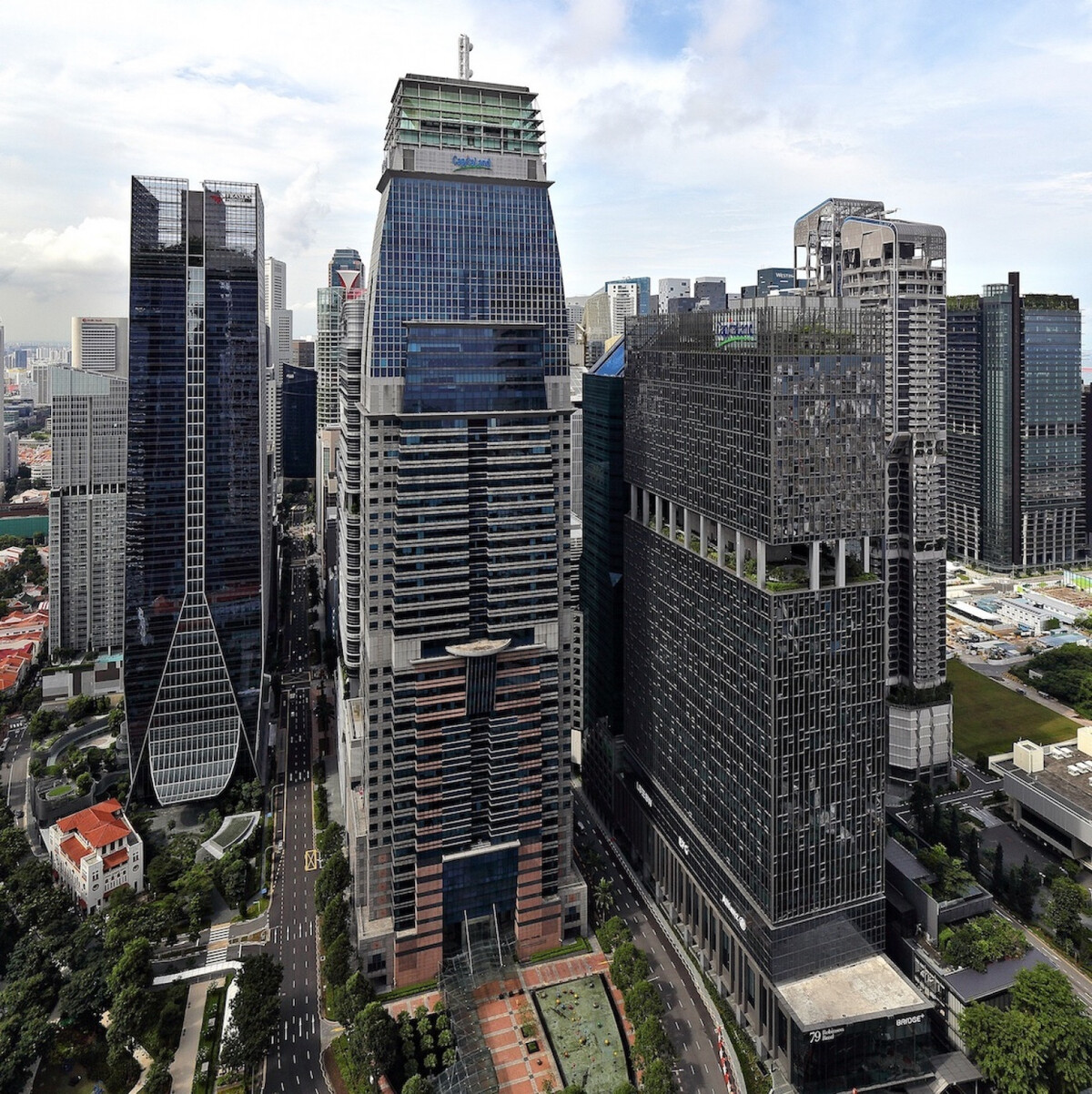
Capital Tower was the first building in Singapore to offer WIFI when it was constructed more than 20 years ago. Since then, the building has kept up with technology while putting an emphasis on employee well-being and energy efficiency.
The HVAC system contains a wheel that recovers cool air to maintain the air chiller temperature, which lowers the amount of energy used for heating and cooling. The building also has smart lighting fixtures installed throughout. To assure occupant safety, comfort, and productivity, IoT sensors measure air temperature, humidity, and CO2 levels. (Studies indicate that increased carbon dioxide levels harm cognitive function).
In addition, sensors that measure carbon monoxide, a deadly gas, are installed in the building’s garage. To remove the hazardous gas when levels are too high, an exhaust fan is turned on. When the air is safe, the fan turns off., and as it is the main purpose in smart building examples, health risks, and energy waste are decreased as a result.
8. TOTTENHAM HOTSPUR STADIUM-LONDON, ENGLAND, UNITED KINGDOM
- Location: London, England, United Kingdom
- Type: stadium
- Size: 105 by 68 meters (114.8 yd. × 74.4 yd.)
- Architect: Populous
- Completion Date: April 3, 2019
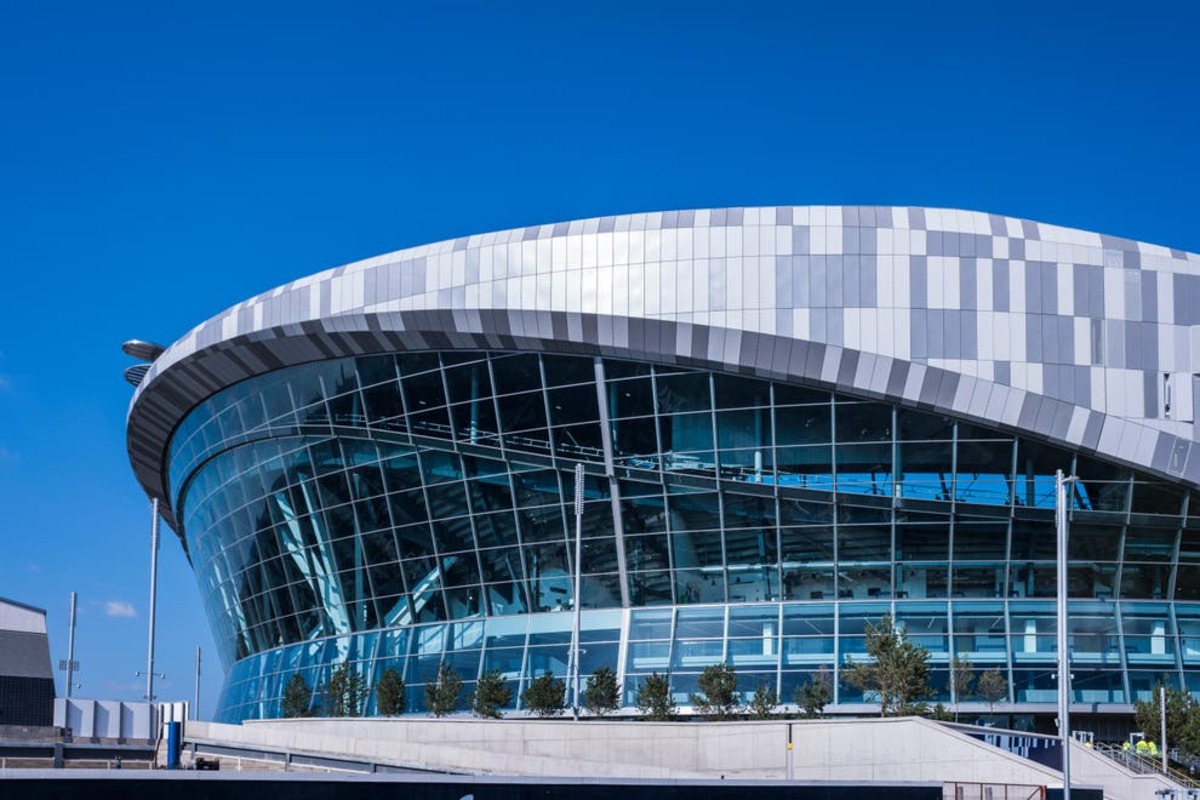
Not just commercial buildings are embracing the smart building revolution. Tottenham Hotspur Stadium, which hosts both British football (soccer to Americans) and the rare NFL game, has been dubbed “Europe’s most technologically advanced stadium,” one of the world’s amazing smart building examples. Turnstiles, CCTV, point-of-sale systems, and even back-office computers are supported by an integrated network.
Viewers may see anything from safety advisories to tactical briefings thanks to the 1,800 screens with zone-specific material, including those in the locker rooms of the teams. Concession stand activity is monitored by observers to prevent unmanageable crowds. One of the 1,641 Wi-Fi access points located throughout the stadium allows visitors to access the official app.
The goal of these technical developments is to give sports fans an outstanding experience so they will come early, stay late, and spend money. According to IT director Sanjeev Katwa, “Technology has enabled those new revenue opportunities… We’re opening up three hours before kick-off to aid revenue but also to improve the flow of people around the building.” That is undoubtedly preferable to battling tens of thousands of other spectators to exit the stadium after the game.
9. THE CRYSTAL
- Location: London, UK
- Type: Exhibition Center
- Size: 19 stories / 22,300 sq. meter
- Architect: Wilkinson Eyre Architects
- Completion Date: 2012
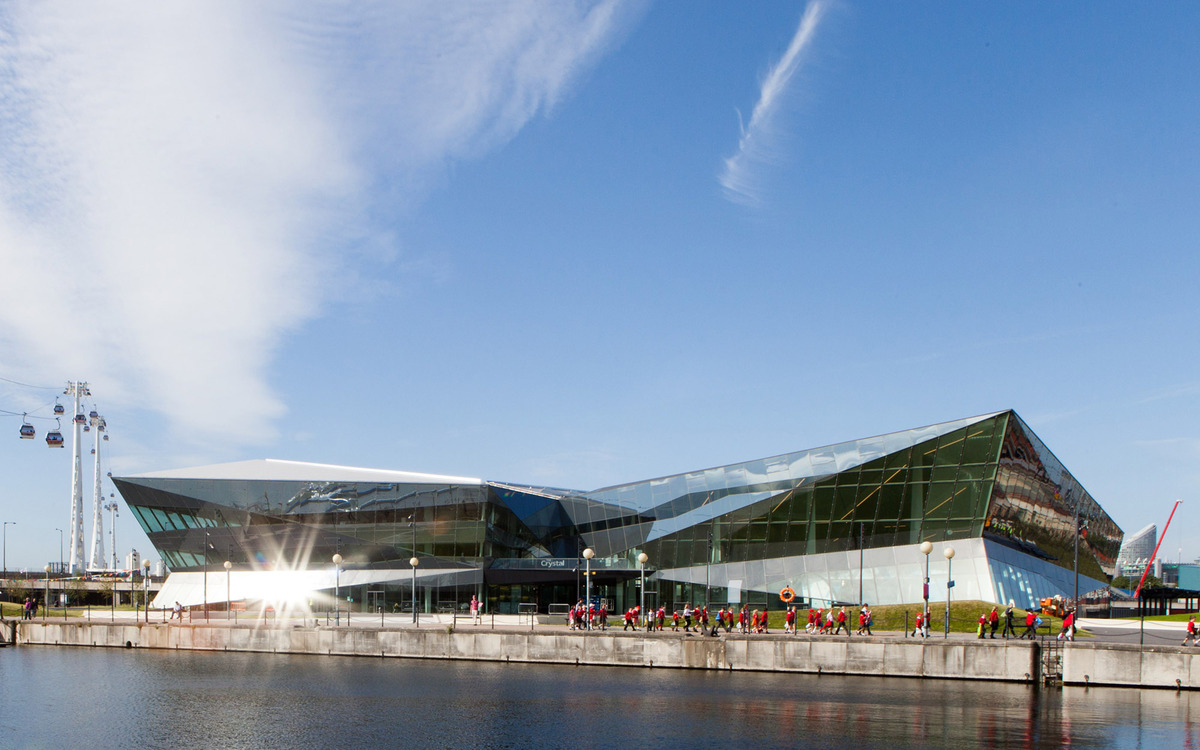
The final case study on the smart building examples is the Crystal, a project commissioned by Siemens, which aims to serve as an example of how smart building technology can make structures more environmentally friendly. The unusual faceted design, resembling a quartz crystal turned on its side, serves more than just decorative purposes. A unique argon-filled glass was used in the design to let in around 70% of visible light but only about 30% of heat, maximizing the utilization of natural lighting.
The Building Energy Management System (BEMS), which regulates all of Crystal’s electrical and mechanical operations, including its black water recycling, solar thermal hot water, and solar photovoltaic systems, is what gives the structure its intelligence. The Crystal’s BEMS regulates temperature and lighting as well. It employs daylight sensors to turn off or dim lights when they aren’t needed and opens windows when it is time for natural airflow.
The future of smart buildings
The market for smart buildings is expanding quickly. This market was estimated to be worth $67.8 billion in 2021 by Fortune Business Insights 2022, and it is anticipated to grow to $328 billion in 2029. Trent Morano, vice president of systems technologies at Power Design, and Jim Oldham, senior vice president of business development at Igor, had a meeting to talk about developments and trends in smart building examples, as well as their integrated systems, technology, and automation.
Whether it be through building or smart space automation, the goal of smart buildings is to use technology effectively and economically to create a safe and comfortable environment for people. Trent expands on these subjects in this webinar and identifies five major themes that are now pervasive in the sector:
1. Net Zero and Regulatory Changes
“I don’t think a specific product is the trick here. It’s about understanding the type of leadership action that you can take to impact the race to net zero.”
Buildings are the source of about 36% of carbon emissions. Customers desire – or in some cases need – buildings that use renewable energy and provide visibility into their building’s carbon footprint, and regulations are expanding as we race towards net zero. Working with partners who are keeping an eye on the industry’s future legislative developments is essential given that sustainability is a major goal for many people and that laws are growing quickly.
2. Increasing Energy Consumption and Costs
“It’s no secret that there are growing energy concerns. Buildings are utilizing approximately 50% of water and energy, and the electrical grid is overaged. Now more than ever, there is even more demand for cleaner energy solutions.”
The ability to integrate cutting-edge technologies and systems that provide clean, optimized, automated energy as well as technology that measures energy usage is crucial to reducing costs in light of rising energy consumption and costs.
3. Cyber Security Threats In Smart Building Examples
“We are looking at all control systems: HVAC, elevator, lighting… any avenue someone could potentially use to get into that system from the outside.”
Cybersecurity dangers are top-of-mind in the marketplace, which has been heightened even more by the current geopolitical climate of the world. Raising security posture and employee training are essential in fending off cybersecurity threats because it is believed that four out of ten linked smart buildings are vulnerable to cyberattacks.
4. Changes to Workforce – Hybrid Work
“The home is now an extension of the office. There is a completely different offering on the residential side from the OEMs than on the commercial side. They have different product types and different manufacturers.”
It is not surprising that the impact of the Pandemic on the labor force is one of the factors driving the most significant changes in the market. Since the implementation of COVID-19, firms all over the world have become accustomed to remote and hybrid work, raising many issues regarding the market for smart buildings. Buildings now need new technologies to meet and manage commercial and residential demands as people go back to the office or transition to permanent hybrid positions.
5. Advancement in IoT and PoE solutions
“Clients are looking for fewer systems to manage. They are looking for some form of a centralized platform.”
More than 67% of businesses either have IoT platforms or are in the investment planning stage. It’s crucial to keep an eye on the quick development of technology and collaborate with partners who are continually assessing platforms and capabilities in smart building examples.
Conclusion
These are just a few of the many smart building examples that are currently in use around the world. We have discovered a method to use our data to make our lives simpler, more integrated, and more efficient thanks to the quick advancements in smart technology, freeing up our resources so that we can concentrate on our top priorities.
We now understand the key advantages that these smart building examples have to offer in terms of energy conservation, upkeep, and enhancing residents’ health, happiness, and productivity. Fortunately, the technologies needed to develop these smart building examples with these advantages are becoming more widely available. This only serves to demonstrate how there are more and more options to construct and design more inventive and productive spaces for everyone.
The actual value of smart buildings lies in their ability to make the data they generate understandably and provide insights on top of that, bringing those insights back to the business to improve interactions and processes.
Owners and operators may define more effective operations and have better visibility into the health of the building thanks to smart buildings. While the inhabitants enjoy interesting surroundings, great comfort, and more efficient experiences.
It’s fair to speculate that the day will come when smart, energy-efficient buildings become the standard because the world is focusing on the long-term viability of these technologies, especially in the commercial building sector.
Suggested article for reading:
important construction technology in 2025
World’s Best Modern Architecture Buildings
Resources: Powerdesigninc | Jllt | Iofficecorp | Blockdox | Pcdn | Event
Books:
- The Crystal Londra, Regno Unito
- A state-of-the-art review on artificial intelligence for Smart Buildings Rav Panchalingam & Ka C. Chan
For the pictures: Wilkinsoneyre | 800 fulton market | Edge NYC | Gensler | IloveNY | Vietravel | Nationalgypsum | Edgeprop Independent | Shreejiaqua

